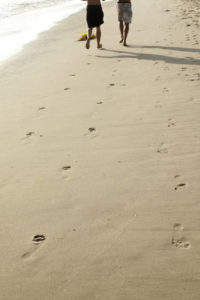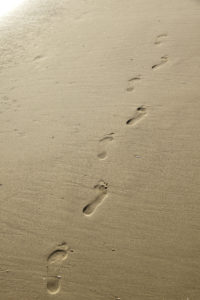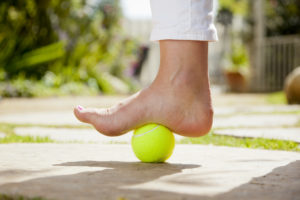Barefoot and Strong: Fitness for Your Feet
By Katy Bowman, MS
Photos by David Young-Wolff

Many yoga practices incorporate both awareness and strengthening exercises of the feet and toes, but are a few extra cues and a lift or two of the big toe enough to undo years of neglect? And when class is over, are we creating an equal amount of damage by our footwear choices when we’re not in class?
The Calf Stretch
As a culture, we have not been very kind to our posterior leg muscles. Not only has chronic footwear use tightened up the back of the legs, but excessive hours of sitting have also contributed to the shortening of these muscles. You may think you already stretch your calves, but not all calf stretches are equal. The stretch below mimics the necessary ankle angles required for a natural stride during a gait cycle.
Place the ball of one foot up on a rolled towel, gently lowering your heel to the floor. Take a few seconds to straighten both legs all the way while keeping the thigh muscles relaxed. Once you’ve gotten used to this position, take a step forward with the other leg.
 Stretching the backs of the legs can (and should) be done throughout the day, especially if you are a professional sitter. Keep a towel in your desk at work for a quick leg lengthener three to four times per work day.
Stretching the backs of the legs can (and should) be done throughout the day, especially if you are a professional sitter. Keep a towel in your desk at work for a quick leg lengthener three to four times per work day.
Stretch the “Gripping” Muscles
Tight forefoot muscles stem from overloading the front of the foot as a result of raised heels, excessive flip-flop wearing, or just years of poor posture and can generate tight, gripping toes. Undo this tension with the “top of the foot” stretch below.
Standing, reach one foot behind you, allowing the tops of the toes to the floor. Try keeping both knees straight and your body upright. Be aware of your pelvis! It will tend to thrust forward and minimize the stretch.
Get On the Ball
The foot was designed to walk long distances over natural surfaces. These surfaces were not only bumpy and rocky paths, but also yielding sands and firmly packed dirt. Natural ground also includes various and random changes in surface. The contours of the earth kept our feet supple by requiring them to form around many different objects. Because the foot spends most of its life against flat, unchanging surfaces, the numerous joints in the foot are not encouraged to move individually. Stepping on surfaces that vary in size and shape are what keep joints mobile, so to innervate, or “wake up” these areas, you’ll use a ball.
 Place the front of the foot on a tennis ball, letting the sides of the foot drape over. Keeping your heel on the ground, slowly move your foot forward, one inch at a time, spending 20 to 30 seconds “just standing” with the ball underneath that area. Once you have worked as far back as you can without lifting your heel, switch to the other foot.
Place the front of the foot on a tennis ball, letting the sides of the foot drape over. Keeping your heel on the ground, slowly move your foot forward, one inch at a time, spending 20 to 30 seconds “just standing” with the ball underneath that area. Once you have worked as far back as you can without lifting your heel, switch to the other foot.
The feet can be just as dextrous as the hands, but having spent years with limited range of motion it takes quite a bit of work to pull our dogs up and out of a well of pain or injury. Practice these three exercises a minimum of twice a day to give your foot pain a leg up.
Katy Bowman, MS combines a study of physics and engineering with a love of anatomy and physiology to address the ABCs of human movement in everyday life. She directs the Restorative Exercise Institute, is the author of the Aligned and Well™ DVD series, and is touring with her first book, Every Woman’s Guide to Foot Pain Relief: restorativeexercise.com.
David Young-Wolff loves to tell a story in a single frame. Never satisfied with the ordinary, he strives to create exciting images with a unique twist. In addition to his assignments, he is currently working on two projects. One is coming to LA, which involves photographing people who are moved to LA from other countries. He is also shooting photos to illustrate an upcoming book, Navajo Mothers, Navajo Daughters. davidyoung-wolff.com
